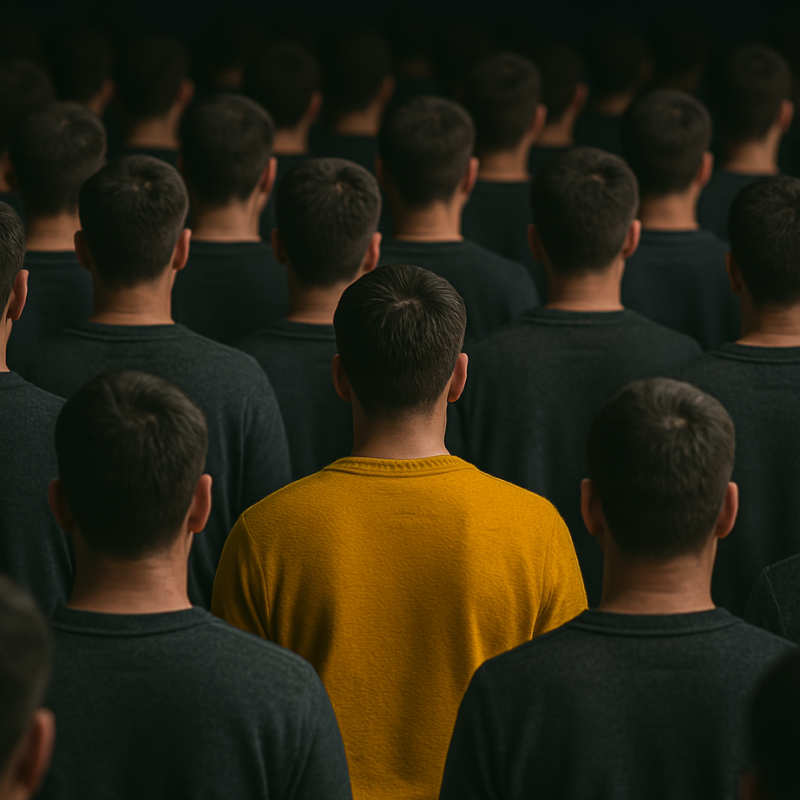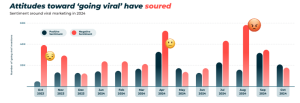Sameness

Key Takeaway:
In a world shaped by AI and algorithms, brand content is becoming dangerously uniform. Research from VML and System1 reveals that 72% of people feel most brands are indistinguishable, and over half of ads fail to evoke any emotion. As generative tools scale content creation, they risk erasing craft and creativity—costing “dull” brands up to $10 million more in media spend to stand out. Yet consumers crave novelty and cultural authenticity. The most effective brands in 2025 will resist algorithmic sameness, blending creative risk-taking, cultural fluency, and AI-enabled agility to reclaim distinctiveness in a sea of optimized content.
Trend Type: Social & Business
Sub-trends: Global Cultures Melt, Sameness, Identity Osmosis
Sameness in the Algorithmic Age
In a world where everything is optimized, everything starts to look the same. The rise of algorithmically driven platforms has accelerated the convergence of aesthetics, tone, and narrative across brand content, resulting in what many call a “dullocalypse.” According to VML and System1’s research presented at Cannes Lions 2024, over half of ads tested failed to trigger any emotional response, while 72% of people agree that most brands feel indistinguishable. As author Kyle Chayka noted, this scaling of success via iteration leads not to uniqueness, but to the lowest common denominator.
This sameness is exacerbated by the influence of AI. Generative models help produce content faster and more efficiently—but at the cost of craft and distinctiveness when left unchecked. AI-assisted platforms are making brand content increasingly interchangeable, just as consumer expectations shift in the opposite direction. According to Eatbigfish’s Adam Morgan, “Dullness is costing businesses a fortune,” with uninspiring brands needing to spend nearly $10 million more on media to break through.
Meanwhile, the expanding creator economy and participatory culture encourage brands to follow trends and mimic viral content. But as Joey Camire (CEO at SYLVAIN) said at Web Summit 2024, many brands risk becoming “vanilla,” driven more by dopamine hits and cultural relevance than real brand substance. In his words: “You can’t sell thirsty”.

Source: Hootsuite Social Media Trends 2024
From Cultural Fluency to Creative Risk-Taking
Beyond algorithms, consumer culture itself is shifting. The fusion of global influences—what we might call “identity osmosis”—is making it easier to access diverse aesthetics, fandoms, and perspectives. People crave novelty and difference, but reject inauthentic appropriation. This tension is giving rise to more demand for cultural fluency: knowing how to participate respectfully and insightfully in an interconnected world. According to Kantar, AI tools like real-time translation and dubbing will accelerate cross-cultural content creation, allowing more localized experiences to gain global traction. But brands must tread carefully—standing out demands more than showing up. It requires true understanding.
Consumers are also getting smarter about how content works. Campaigns like Samsung’s Flipvertising playfully invited audiences to manipulate search algorithms, showing how “algorithmic fluency” is becoming mainstream. Simultaneously, social platforms are evolving from polished feeds into spaces for entertainment-first, personality-driven content. Hootsuite’s 2024 Social Trends report notes that nearly half of brands now produce content designed to entertain, inform, or educate—while a growing segment (25%) commits 80%+ of their output to creative risk-taking.
In a media environment saturated with optimized sameness, creativity becomes the differentiator. The most successful brands will marry agility with authenticity, and pair algorithmic insight with cultural relevance. This doesn’t mean abandoning AI, but rather combining it with human judgment, distinctive storytelling, and bold design.
Use Cases
Sameness: Brands risk becoming “vanilla” by chasing trends & cultural moments without authenticity. Focus on long-term growth, not just “going viral.” Effective marketing = cultural relevance + brand consistency. Treat product as brand, humanize insights, & integrate efforts to drive value.
Sameness: Duolingo’s mascot is dead. The green owl that has haunted the notifications for years has apparently been killed off. Duolingo made the announcement online, and suddenly, media outlets, celebrities, and social media users were all talking about it. But was this just a random decision, or was it actually a brilliant marketing move?
Sameness: Flipvertising managed to resonate with ad-sceptical millennials and Gen Z. To launch the new Samsung Galaxy Z Flip4, CHEP used an innovative approach to flip the media targeting model on its head. The agency created a YouTube pre-roll that contained a free Flip4, then made it almost impossible to get served this elusive ad. The process of doing this had even Google’s own technologists scratching their heads. The best part? With every search, the audience changed their algorithm to show them endless unpaid, unsponsored Samsung content.
Sameness: Unhinged, random and horrifying are just a few words that you probably wouldn’t think of when describing a cookie. This is where we are at right now, at least in the case of Nutter Butter.
Use Cases
Sub-Trend Sources
Global Cultures Melt: Dentsu Creative Trends , Kantar's Media Trends & Predictions
Sameness: Dentsu Creative Trends, Hootsuite Social Media Trends, VML The Future 100
Identity Osmosis: Tik Tok Trends
What to Read Next
Good Enough Life
From Aspirational To Sufficient Young people are abandoning broken milestones and rewriting the rules of adulthood. According to Deloitte’s 2024 Global Millennial Survey, 64% of Gen Z and Millennials believe[...]
Balancing Reality
Rebalancing Digital and Physical Life This trend has been unfolding since the Covid era, when people rediscovered nature, in-person socialization, and tangible connections. In sum, as digital saturation grows, people[...]
Ambivalent Reality
The Erosion of Digital Trust As generative AI becomes more embedded in everyday life, trust in digital spaces is eroding. The ease with which content can be generated and manipulated[...]
What to Read Next
Good Enough Life
From Aspirational To Sufficient Young people are abandoning broken milestones and rewriting the rules of adulthood. According to Deloitte’s 2024 Global Millennial Survey, 64% of[...]
Balancing Reality
Rebalancing Digital and Physical Life This trend has been unfolding since the Covid era, when people rediscovered nature, in-person socialization, and tangible connections. In sum,[...]
Ambivalent Reality
The Erosion of Digital Trust As generative AI becomes more embedded in everyday life, trust in digital spaces is eroding. The ease with which content[...]


